Project Execution Planning and Management: A Detailed Report
VerifiedAdded on 2020/02/24
|11
|2594
|102
Report
AI Summary
This report provides a detailed analysis of project execution planning and management, focusing on key aspects such as project delivery systems, financial contract types, and procurement methods. The report begins by comparing and contrasting three project delivery systems: Design-Bid-Build, Design-Build, and CM @ Risk, evaluating them based on criteria like delivery schedule, complexity, design level, risk assessment, cost, staff experience, oversight, and competition. The Design-Build method is recommended for the case study. The report then examines financial contract types, including Lump sum, Guaranteed Maximum Price, and Cost plus Fixed Fee contracts, and suggests the Lump sum contract as the most suitable for the given scenario. Finally, the report explores procurement methods, comparing Competitive, Negotiated, and Best Value approaches, recommending the Best Value method due to its emphasis on contractor experience and quality. The report concludes with a comprehensive evaluation and recommendations for effective project execution.
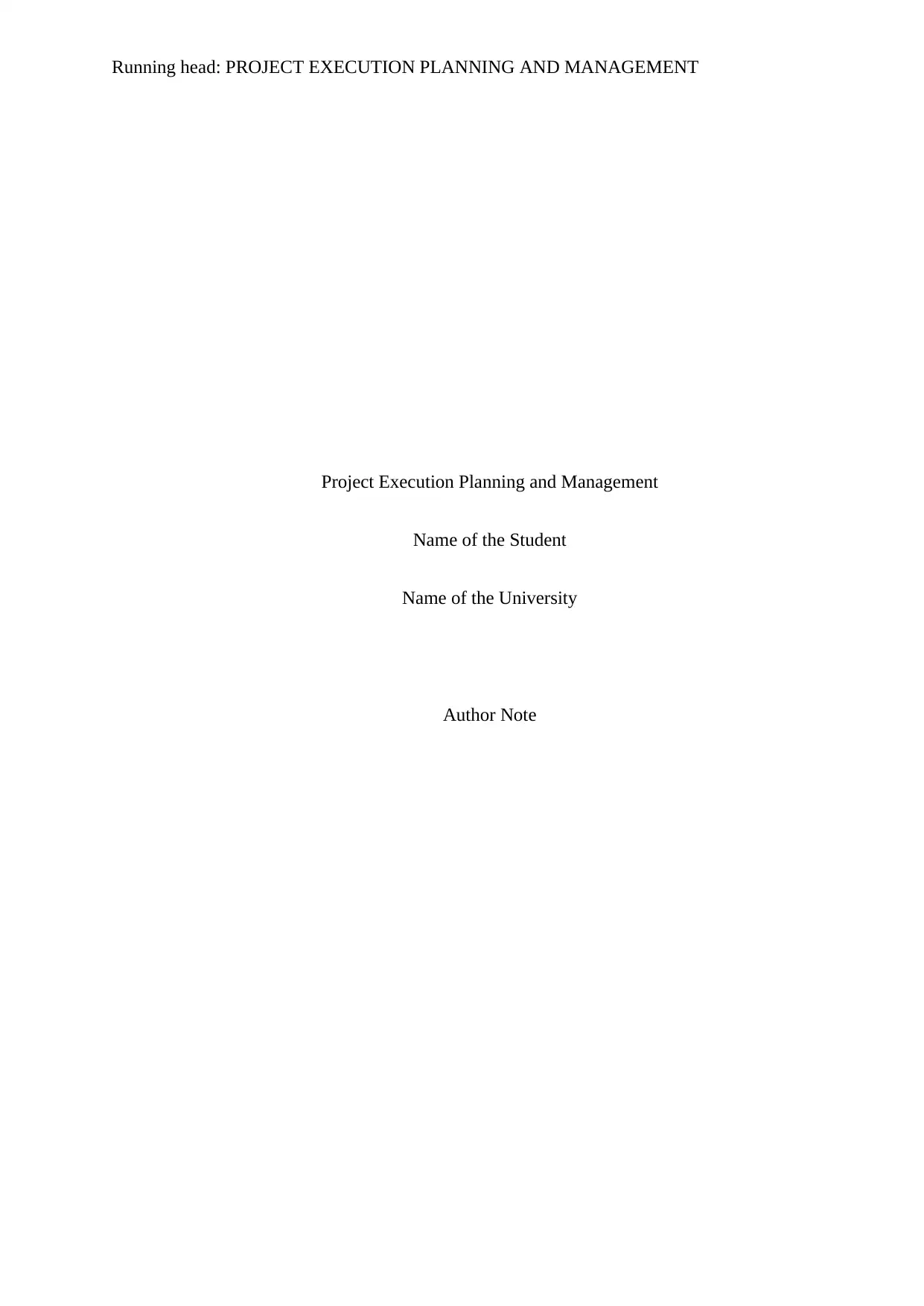
Running head: PROJECT EXECUTION PLANNING AND MANAGEMENT
Project Execution Planning and Management
Name of the Student
Name of the University
Author Note
Project Execution Planning and Management
Name of the Student
Name of the University
Author Note
Paraphrase This Document
Need a fresh take? Get an instant paraphrase of this document with our AI Paraphraser
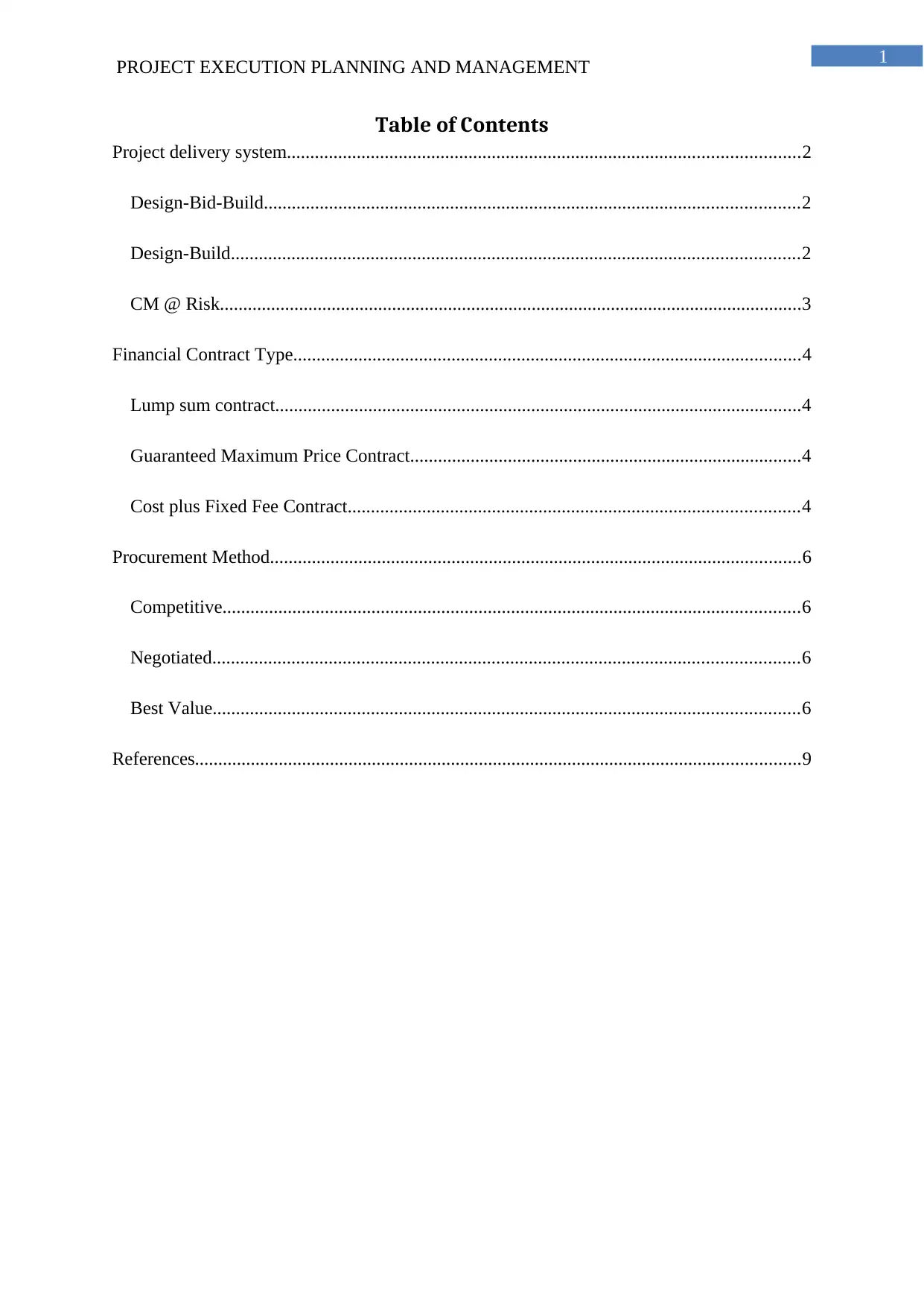
1
PROJECT EXECUTION PLANNING AND MANAGEMENT
Table of Contents
Project delivery system..............................................................................................................2
Design-Bid-Build...................................................................................................................2
Design-Build..........................................................................................................................2
CM @ Risk.............................................................................................................................3
Financial Contract Type.............................................................................................................4
Lump sum contract.................................................................................................................4
Guaranteed Maximum Price Contract....................................................................................4
Cost plus Fixed Fee Contract.................................................................................................4
Procurement Method..................................................................................................................6
Competitive............................................................................................................................6
Negotiated..............................................................................................................................6
Best Value..............................................................................................................................6
References..................................................................................................................................9
PROJECT EXECUTION PLANNING AND MANAGEMENT
Table of Contents
Project delivery system..............................................................................................................2
Design-Bid-Build...................................................................................................................2
Design-Build..........................................................................................................................2
CM @ Risk.............................................................................................................................3
Financial Contract Type.............................................................................................................4
Lump sum contract.................................................................................................................4
Guaranteed Maximum Price Contract....................................................................................4
Cost plus Fixed Fee Contract.................................................................................................4
Procurement Method..................................................................................................................6
Competitive............................................................................................................................6
Negotiated..............................................................................................................................6
Best Value..............................................................................................................................6
References..................................................................................................................................9
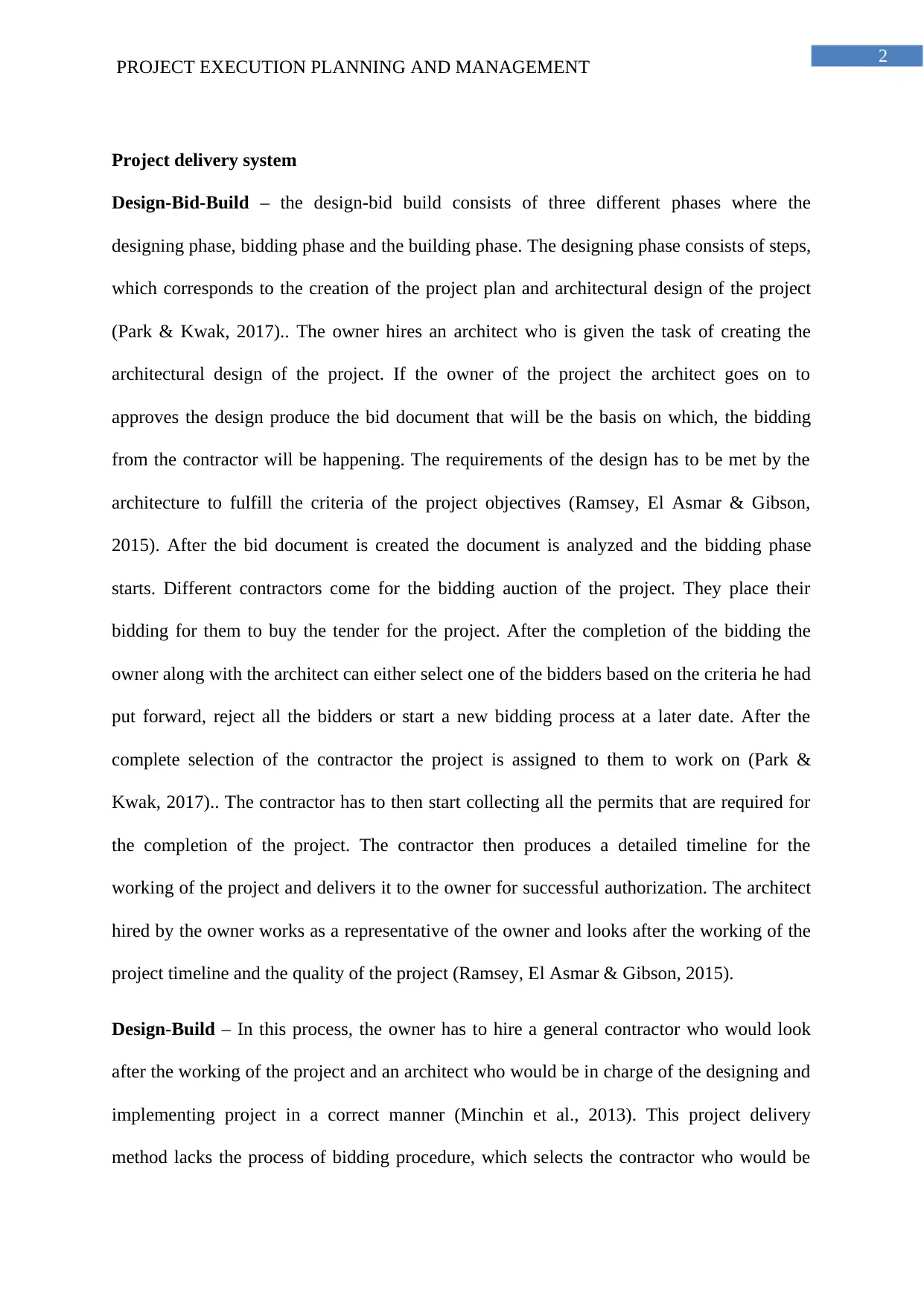
2
PROJECT EXECUTION PLANNING AND MANAGEMENT
Project delivery system
Design-Bid-Build – the design-bid build consists of three different phases where the
designing phase, bidding phase and the building phase. The designing phase consists of steps,
which corresponds to the creation of the project plan and architectural design of the project
(Park & Kwak, 2017).. The owner hires an architect who is given the task of creating the
architectural design of the project. If the owner of the project the architect goes on to
approves the design produce the bid document that will be the basis on which, the bidding
from the contractor will be happening. The requirements of the design has to be met by the
architecture to fulfill the criteria of the project objectives (Ramsey, El Asmar & Gibson,
2015). After the bid document is created the document is analyzed and the bidding phase
starts. Different contractors come for the bidding auction of the project. They place their
bidding for them to buy the tender for the project. After the completion of the bidding the
owner along with the architect can either select one of the bidders based on the criteria he had
put forward, reject all the bidders or start a new bidding process at a later date. After the
complete selection of the contractor the project is assigned to them to work on (Park &
Kwak, 2017).. The contractor has to then start collecting all the permits that are required for
the completion of the project. The contractor then produces a detailed timeline for the
working of the project and delivers it to the owner for successful authorization. The architect
hired by the owner works as a representative of the owner and looks after the working of the
project timeline and the quality of the project (Ramsey, El Asmar & Gibson, 2015).
Design-Build – In this process, the owner has to hire a general contractor who would look
after the working of the project and an architect who would be in charge of the designing and
implementing project in a correct manner (Minchin et al., 2013). This project delivery
method lacks the process of bidding procedure, which selects the contractor who would be
PROJECT EXECUTION PLANNING AND MANAGEMENT
Project delivery system
Design-Bid-Build – the design-bid build consists of three different phases where the
designing phase, bidding phase and the building phase. The designing phase consists of steps,
which corresponds to the creation of the project plan and architectural design of the project
(Park & Kwak, 2017).. The owner hires an architect who is given the task of creating the
architectural design of the project. If the owner of the project the architect goes on to
approves the design produce the bid document that will be the basis on which, the bidding
from the contractor will be happening. The requirements of the design has to be met by the
architecture to fulfill the criteria of the project objectives (Ramsey, El Asmar & Gibson,
2015). After the bid document is created the document is analyzed and the bidding phase
starts. Different contractors come for the bidding auction of the project. They place their
bidding for them to buy the tender for the project. After the completion of the bidding the
owner along with the architect can either select one of the bidders based on the criteria he had
put forward, reject all the bidders or start a new bidding process at a later date. After the
complete selection of the contractor the project is assigned to them to work on (Park &
Kwak, 2017).. The contractor has to then start collecting all the permits that are required for
the completion of the project. The contractor then produces a detailed timeline for the
working of the project and delivers it to the owner for successful authorization. The architect
hired by the owner works as a representative of the owner and looks after the working of the
project timeline and the quality of the project (Ramsey, El Asmar & Gibson, 2015).
Design-Build – In this process, the owner has to hire a general contractor who would look
after the working of the project and an architect who would be in charge of the designing and
implementing project in a correct manner (Minchin et al., 2013). This project delivery
method lacks the process of bidding procedure, which selects the contractor who would be
⊘ This is a preview!⊘
Do you want full access?
Subscribe today to unlock all pages.

Trusted by 1+ million students worldwide
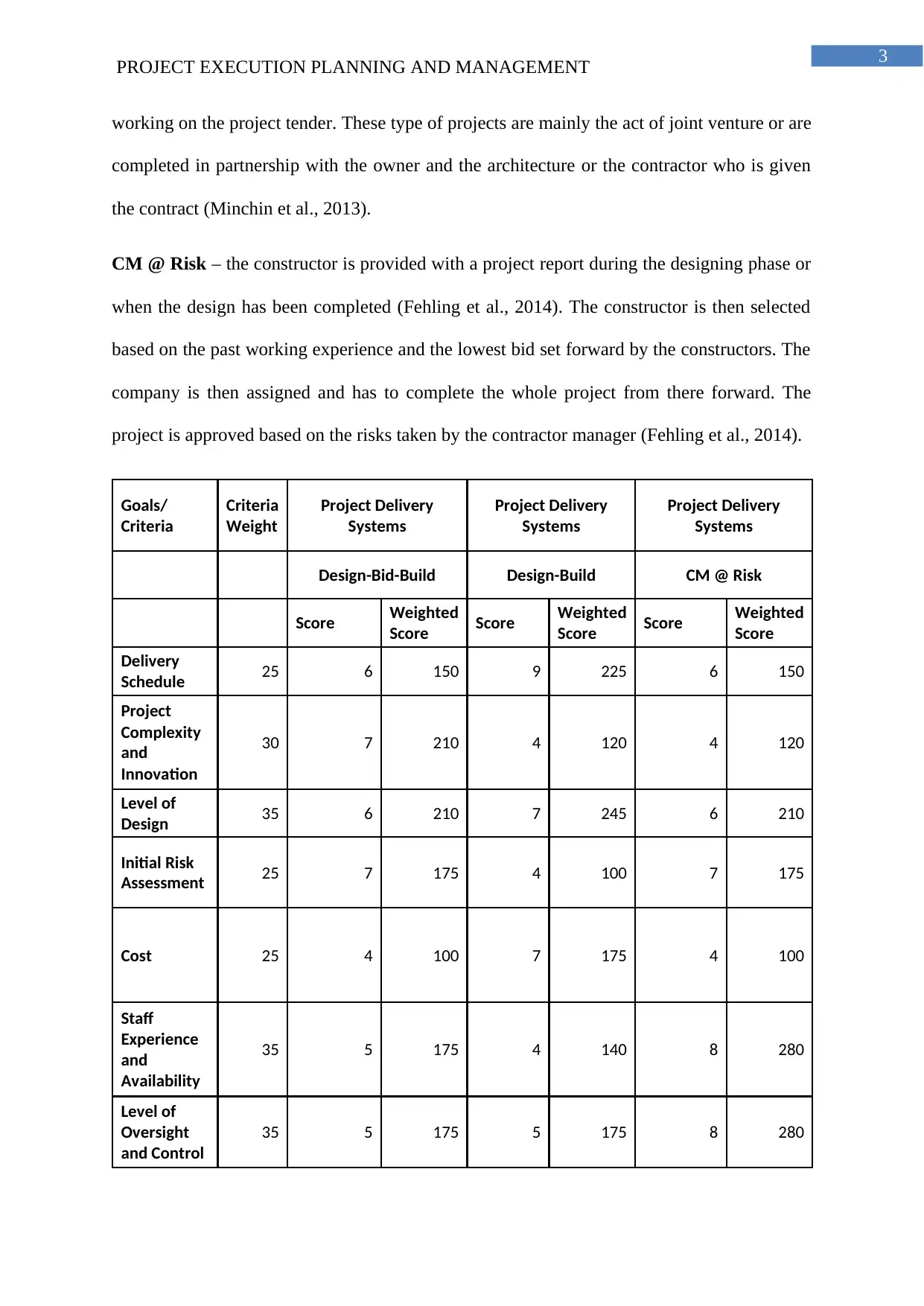
3
PROJECT EXECUTION PLANNING AND MANAGEMENT
working on the project tender. These type of projects are mainly the act of joint venture or are
completed in partnership with the owner and the architecture or the contractor who is given
the contract (Minchin et al., 2013).
CM @ Risk – the constructor is provided with a project report during the designing phase or
when the design has been completed (Fehling et al., 2014). The constructor is then selected
based on the past working experience and the lowest bid set forward by the constructors. The
company is then assigned and has to complete the whole project from there forward. The
project is approved based on the risks taken by the contractor manager (Fehling et al., 2014).
Goals/
Criteria
Criteria
Weight
Project Delivery
Systems
Project Delivery
Systems
Project Delivery
Systems
Design-Bid-Build Design-Build CM @ Risk
Score Weighted
Score Score Weighted
Score Score Weighted
Score
Delivery
Schedule 25 6 150 9 225 6 150
Project
Complexity
and
Innovation
30 7 210 4 120 4 120
Level of
Design 35 6 210 7 245 6 210
Initial Risk
Assessment 25 7 175 4 100 7 175
Cost 25 4 100 7 175 4 100
Staff
Experience
and
Availability
35 5 175 4 140 8 280
Level of
Oversight
and Control
35 5 175 5 175 8 280
PROJECT EXECUTION PLANNING AND MANAGEMENT
working on the project tender. These type of projects are mainly the act of joint venture or are
completed in partnership with the owner and the architecture or the contractor who is given
the contract (Minchin et al., 2013).
CM @ Risk – the constructor is provided with a project report during the designing phase or
when the design has been completed (Fehling et al., 2014). The constructor is then selected
based on the past working experience and the lowest bid set forward by the constructors. The
company is then assigned and has to complete the whole project from there forward. The
project is approved based on the risks taken by the contractor manager (Fehling et al., 2014).
Goals/
Criteria
Criteria
Weight
Project Delivery
Systems
Project Delivery
Systems
Project Delivery
Systems
Design-Bid-Build Design-Build CM @ Risk
Score Weighted
Score Score Weighted
Score Score Weighted
Score
Delivery
Schedule 25 6 150 9 225 6 150
Project
Complexity
and
Innovation
30 7 210 4 120 4 120
Level of
Design 35 6 210 7 245 6 210
Initial Risk
Assessment 25 7 175 4 100 7 175
Cost 25 4 100 7 175 4 100
Staff
Experience
and
Availability
35 5 175 4 140 8 280
Level of
Oversight
and Control
35 5 175 5 175 8 280
Paraphrase This Document
Need a fresh take? Get an instant paraphrase of this document with our AI Paraphraser

4
PROJECT EXECUTION PLANNING AND MANAGEMENT
Competition
and
Contractor
Experience
30 8 240 6 180 5 150
Total 240 1435 1360 1465
The three processes has been critically evaluated and the case study has been studied with
care. Upon successful evaluation, it has been found that the best project delivery system to
select for the given case study would be the design build process. As the construction time
line for the case study is 7 years so the design build would be the best method to be used by
the construction company. The tender has many risks and has to be completely evaluated by
the contractor who has taken the job. The marking score provided in the table above has been
provided based on the case study.
Financial Contract Type
Lump sum contract – the contract is of a stipulated amount that is confirmed between the
owners of the project and the contractor who has agreed to work on the project (Minchin et l.,
2014). The major risks, which will be considered during the execution of the project, will be
left for the contractor to resolve. The payment is paid in full with the consideration of over
head costs, profit margin and the labor costs.
Guaranteed Maximum Price Contract – this contract is evaluated based on the actual cost
compensation of the contractor with the addition of the profit margin of the contractor being
added to it (Lee & Rao, 2015). The contractor is responsible for the expenditures that will be
applicable for the project completion. If there is a shortage in the funds provided then the
owner has to evaluate the project again and then provide the money required for the task
(Burr, 2016).
PROJECT EXECUTION PLANNING AND MANAGEMENT
Competition
and
Contractor
Experience
30 8 240 6 180 5 150
Total 240 1435 1360 1465
The three processes has been critically evaluated and the case study has been studied with
care. Upon successful evaluation, it has been found that the best project delivery system to
select for the given case study would be the design build process. As the construction time
line for the case study is 7 years so the design build would be the best method to be used by
the construction company. The tender has many risks and has to be completely evaluated by
the contractor who has taken the job. The marking score provided in the table above has been
provided based on the case study.
Financial Contract Type
Lump sum contract – the contract is of a stipulated amount that is confirmed between the
owners of the project and the contractor who has agreed to work on the project (Minchin et l.,
2014). The major risks, which will be considered during the execution of the project, will be
left for the contractor to resolve. The payment is paid in full with the consideration of over
head costs, profit margin and the labor costs.
Guaranteed Maximum Price Contract – this contract is evaluated based on the actual cost
compensation of the contractor with the addition of the profit margin of the contractor being
added to it (Lee & Rao, 2015). The contractor is responsible for the expenditures that will be
applicable for the project completion. If there is a shortage in the funds provided then the
owner has to evaluate the project again and then provide the money required for the task
(Burr, 2016).
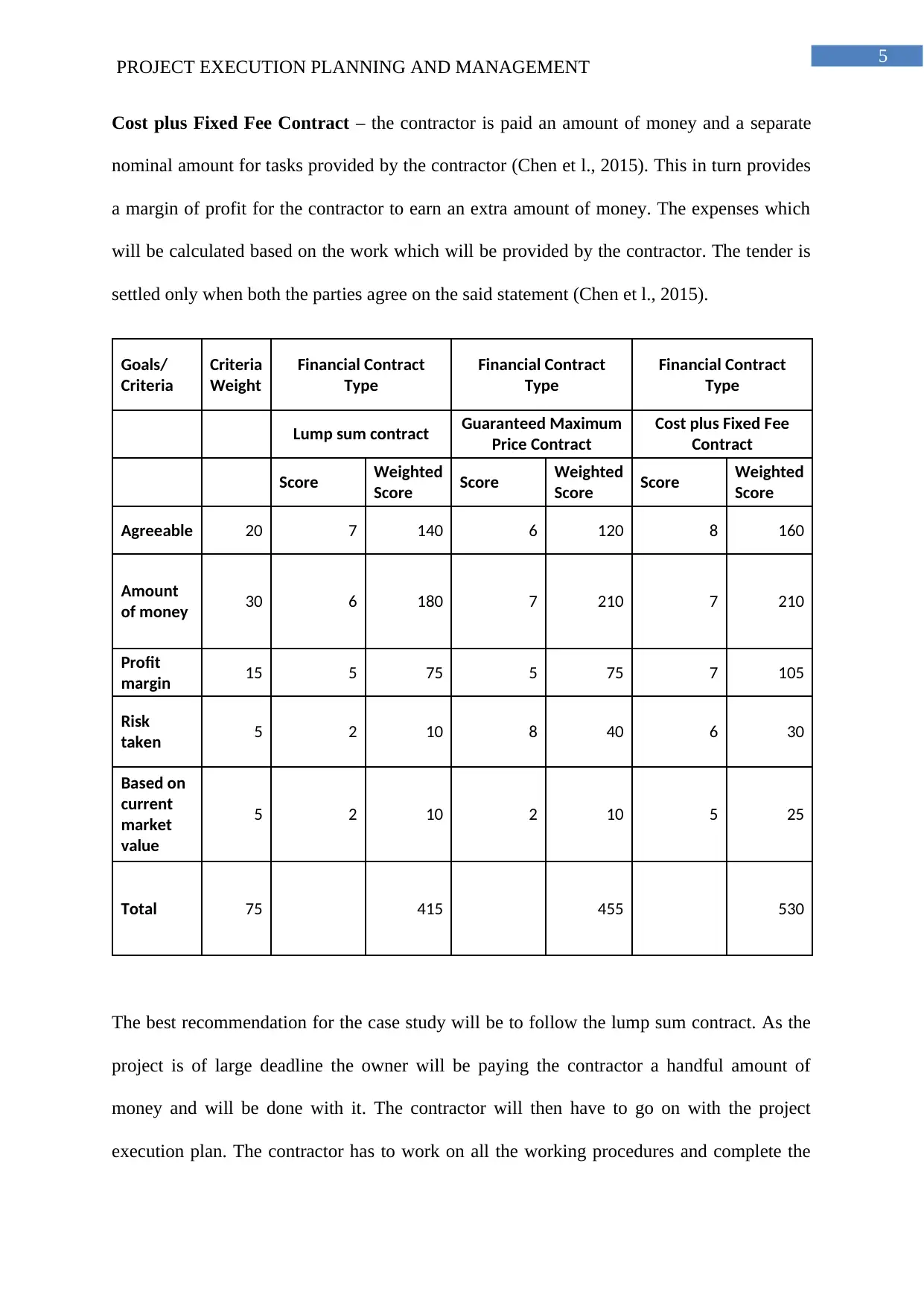
5
PROJECT EXECUTION PLANNING AND MANAGEMENT
Cost plus Fixed Fee Contract – the contractor is paid an amount of money and a separate
nominal amount for tasks provided by the contractor (Chen et l., 2015). This in turn provides
a margin of profit for the contractor to earn an extra amount of money. The expenses which
will be calculated based on the work which will be provided by the contractor. The tender is
settled only when both the parties agree on the said statement (Chen et l., 2015).
Goals/
Criteria
Criteria
Weight
Financial Contract
Type
Financial Contract
Type
Financial Contract
Type
Lump sum contract Guaranteed Maximum
Price Contract
Cost plus Fixed Fee
Contract
Score Weighted
Score Score Weighted
Score Score Weighted
Score
Agreeable 20 7 140 6 120 8 160
Amount
of money 30 6 180 7 210 7 210
Profit
margin 15 5 75 5 75 7 105
Risk
taken 5 2 10 8 40 6 30
Based on
current
market
value
5 2 10 2 10 5 25
Total 75 415 455 530
The best recommendation for the case study will be to follow the lump sum contract. As the
project is of large deadline the owner will be paying the contractor a handful amount of
money and will be done with it. The contractor will then have to go on with the project
execution plan. The contractor has to work on all the working procedures and complete the
PROJECT EXECUTION PLANNING AND MANAGEMENT
Cost plus Fixed Fee Contract – the contractor is paid an amount of money and a separate
nominal amount for tasks provided by the contractor (Chen et l., 2015). This in turn provides
a margin of profit for the contractor to earn an extra amount of money. The expenses which
will be calculated based on the work which will be provided by the contractor. The tender is
settled only when both the parties agree on the said statement (Chen et l., 2015).
Goals/
Criteria
Criteria
Weight
Financial Contract
Type
Financial Contract
Type
Financial Contract
Type
Lump sum contract Guaranteed Maximum
Price Contract
Cost plus Fixed Fee
Contract
Score Weighted
Score Score Weighted
Score Score Weighted
Score
Agreeable 20 7 140 6 120 8 160
Amount
of money 30 6 180 7 210 7 210
Profit
margin 15 5 75 5 75 7 105
Risk
taken 5 2 10 8 40 6 30
Based on
current
market
value
5 2 10 2 10 5 25
Total 75 415 455 530
The best recommendation for the case study will be to follow the lump sum contract. As the
project is of large deadline the owner will be paying the contractor a handful amount of
money and will be done with it. The contractor will then have to go on with the project
execution plan. The contractor has to work on all the working procedures and complete the
⊘ This is a preview!⊘
Do you want full access?
Subscribe today to unlock all pages.

Trusted by 1+ million students worldwide
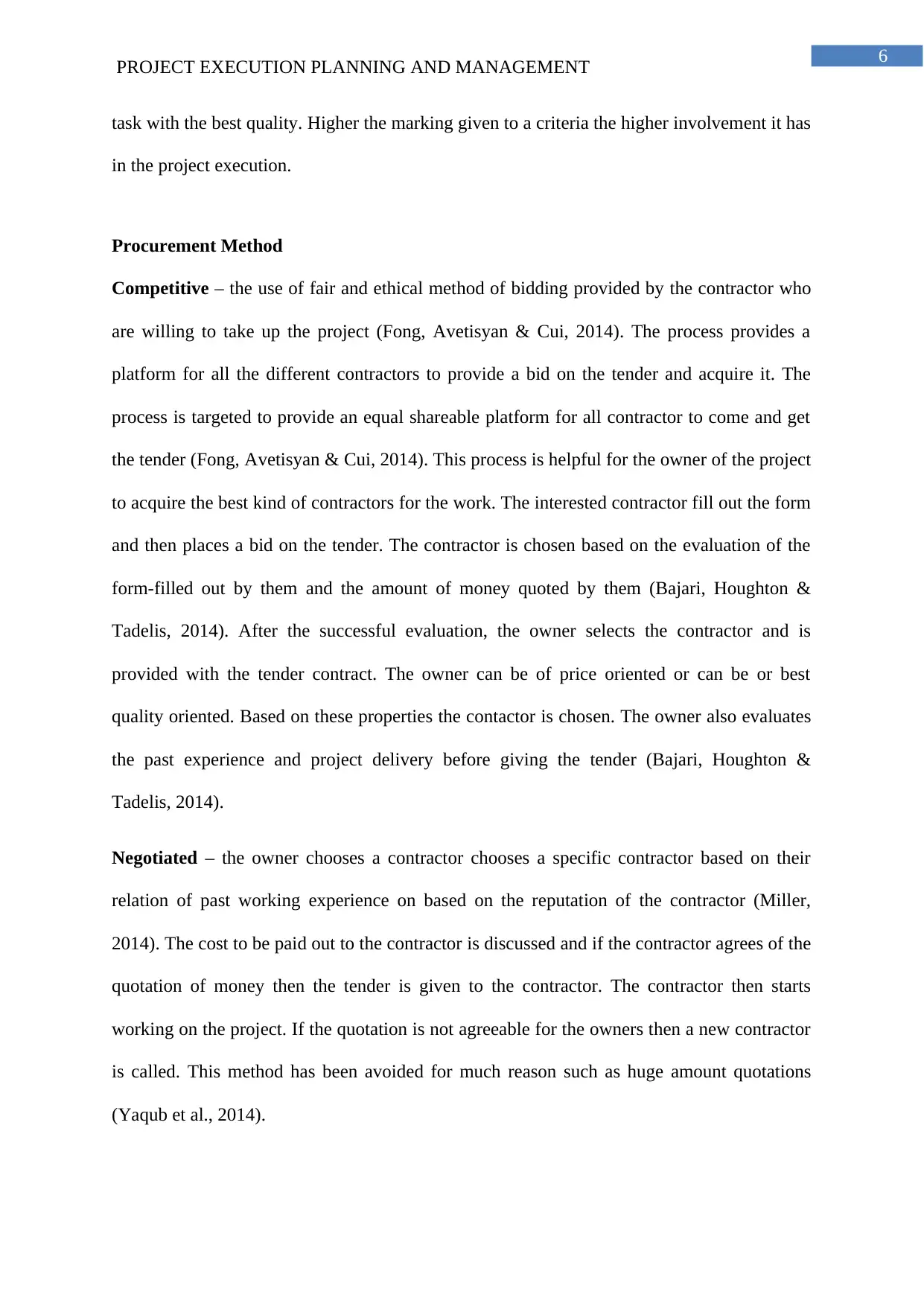
6
PROJECT EXECUTION PLANNING AND MANAGEMENT
task with the best quality. Higher the marking given to a criteria the higher involvement it has
in the project execution.
Procurement Method
Competitive – the use of fair and ethical method of bidding provided by the contractor who
are willing to take up the project (Fong, Avetisyan & Cui, 2014). The process provides a
platform for all the different contractors to provide a bid on the tender and acquire it. The
process is targeted to provide an equal shareable platform for all contractor to come and get
the tender (Fong, Avetisyan & Cui, 2014). This process is helpful for the owner of the project
to acquire the best kind of contractors for the work. The interested contractor fill out the form
and then places a bid on the tender. The contractor is chosen based on the evaluation of the
form-filled out by them and the amount of money quoted by them (Bajari, Houghton &
Tadelis, 2014). After the successful evaluation, the owner selects the contractor and is
provided with the tender contract. The owner can be of price oriented or can be or best
quality oriented. Based on these properties the contactor is chosen. The owner also evaluates
the past experience and project delivery before giving the tender (Bajari, Houghton &
Tadelis, 2014).
Negotiated – the owner chooses a contractor chooses a specific contractor based on their
relation of past working experience on based on the reputation of the contractor (Miller,
2014). The cost to be paid out to the contractor is discussed and if the contractor agrees of the
quotation of money then the tender is given to the contractor. The contractor then starts
working on the project. If the quotation is not agreeable for the owners then a new contractor
is called. This method has been avoided for much reason such as huge amount quotations
(Yaqub et al., 2014).
PROJECT EXECUTION PLANNING AND MANAGEMENT
task with the best quality. Higher the marking given to a criteria the higher involvement it has
in the project execution.
Procurement Method
Competitive – the use of fair and ethical method of bidding provided by the contractor who
are willing to take up the project (Fong, Avetisyan & Cui, 2014). The process provides a
platform for all the different contractors to provide a bid on the tender and acquire it. The
process is targeted to provide an equal shareable platform for all contractor to come and get
the tender (Fong, Avetisyan & Cui, 2014). This process is helpful for the owner of the project
to acquire the best kind of contractors for the work. The interested contractor fill out the form
and then places a bid on the tender. The contractor is chosen based on the evaluation of the
form-filled out by them and the amount of money quoted by them (Bajari, Houghton &
Tadelis, 2014). After the successful evaluation, the owner selects the contractor and is
provided with the tender contract. The owner can be of price oriented or can be or best
quality oriented. Based on these properties the contactor is chosen. The owner also evaluates
the past experience and project delivery before giving the tender (Bajari, Houghton &
Tadelis, 2014).
Negotiated – the owner chooses a contractor chooses a specific contractor based on their
relation of past working experience on based on the reputation of the contractor (Miller,
2014). The cost to be paid out to the contractor is discussed and if the contractor agrees of the
quotation of money then the tender is given to the contractor. The contractor then starts
working on the project. If the quotation is not agreeable for the owners then a new contractor
is called. This method has been avoided for much reason such as huge amount quotations
(Yaqub et al., 2014).
Paraphrase This Document
Need a fresh take? Get an instant paraphrase of this document with our AI Paraphraser
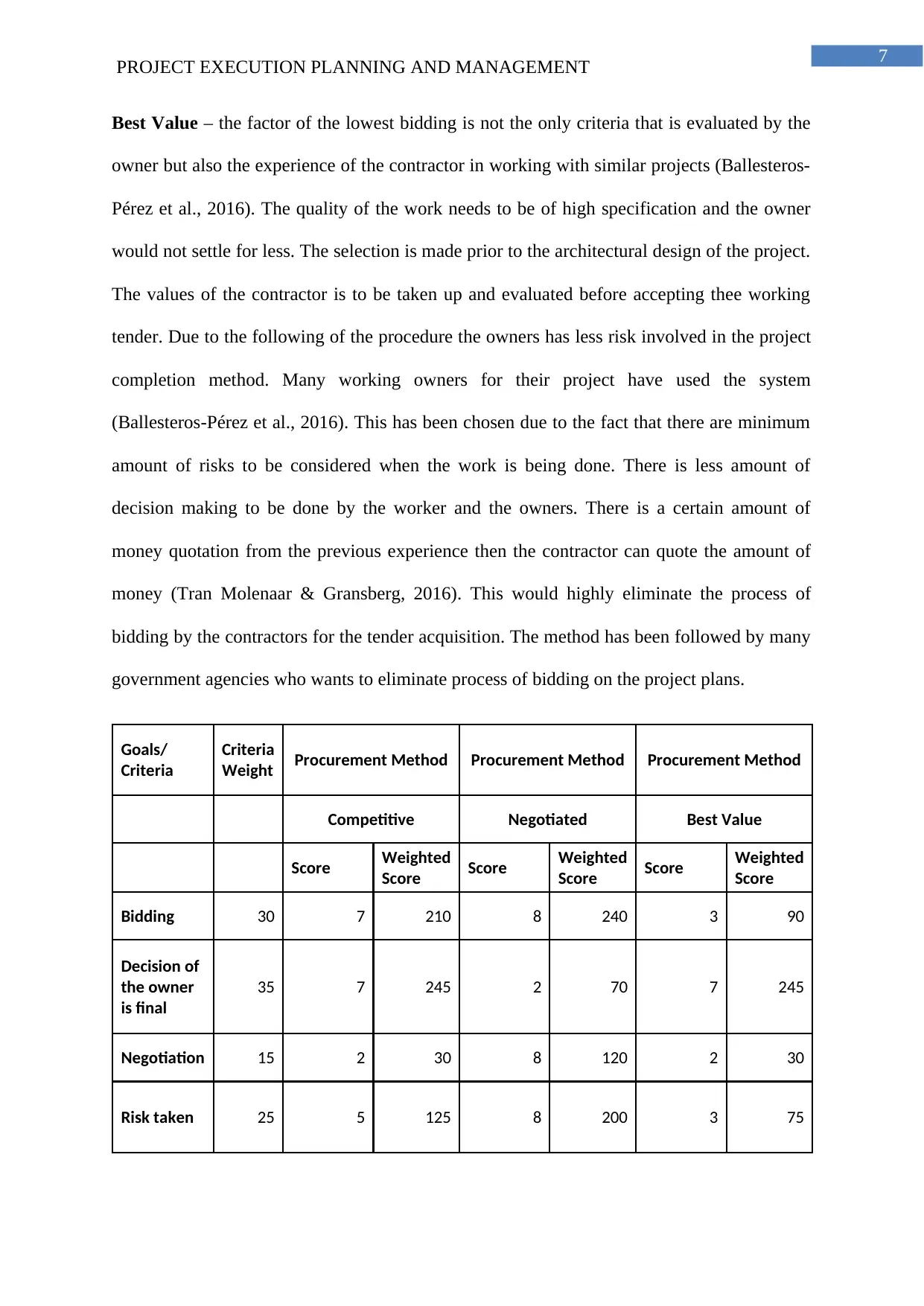
7
PROJECT EXECUTION PLANNING AND MANAGEMENT
Best Value – the factor of the lowest bidding is not the only criteria that is evaluated by the
owner but also the experience of the contractor in working with similar projects (Ballesteros-
Pérez et al., 2016). The quality of the work needs to be of high specification and the owner
would not settle for less. The selection is made prior to the architectural design of the project.
The values of the contractor is to be taken up and evaluated before accepting thee working
tender. Due to the following of the procedure the owners has less risk involved in the project
completion method. Many working owners for their project have used the system
(Ballesteros-Pérez et al., 2016). This has been chosen due to the fact that there are minimum
amount of risks to be considered when the work is being done. There is less amount of
decision making to be done by the worker and the owners. There is a certain amount of
money quotation from the previous experience then the contractor can quote the amount of
money (Tran Molenaar & Gransberg, 2016). This would highly eliminate the process of
bidding by the contractors for the tender acquisition. The method has been followed by many
government agencies who wants to eliminate process of bidding on the project plans.
Goals/
Criteria
Criteria
Weight Procurement Method Procurement Method Procurement Method
Competitive Negotiated Best Value
Score Weighted
Score Score Weighted
Score Score Weighted
Score
Bidding 30 7 210 8 240 3 90
Decision of
the owner
is final
35 7 245 2 70 7 245
Negotiation 15 2 30 8 120 2 30
Risk taken 25 5 125 8 200 3 75
PROJECT EXECUTION PLANNING AND MANAGEMENT
Best Value – the factor of the lowest bidding is not the only criteria that is evaluated by the
owner but also the experience of the contractor in working with similar projects (Ballesteros-
Pérez et al., 2016). The quality of the work needs to be of high specification and the owner
would not settle for less. The selection is made prior to the architectural design of the project.
The values of the contractor is to be taken up and evaluated before accepting thee working
tender. Due to the following of the procedure the owners has less risk involved in the project
completion method. Many working owners for their project have used the system
(Ballesteros-Pérez et al., 2016). This has been chosen due to the fact that there are minimum
amount of risks to be considered when the work is being done. There is less amount of
decision making to be done by the worker and the owners. There is a certain amount of
money quotation from the previous experience then the contractor can quote the amount of
money (Tran Molenaar & Gransberg, 2016). This would highly eliminate the process of
bidding by the contractors for the tender acquisition. The method has been followed by many
government agencies who wants to eliminate process of bidding on the project plans.
Goals/
Criteria
Criteria
Weight Procurement Method Procurement Method Procurement Method
Competitive Negotiated Best Value
Score Weighted
Score Score Weighted
Score Score Weighted
Score
Bidding 30 7 210 8 240 3 90
Decision of
the owner
is final
35 7 245 2 70 7 245
Negotiation 15 2 30 8 120 2 30
Risk taken 25 5 125 8 200 3 75
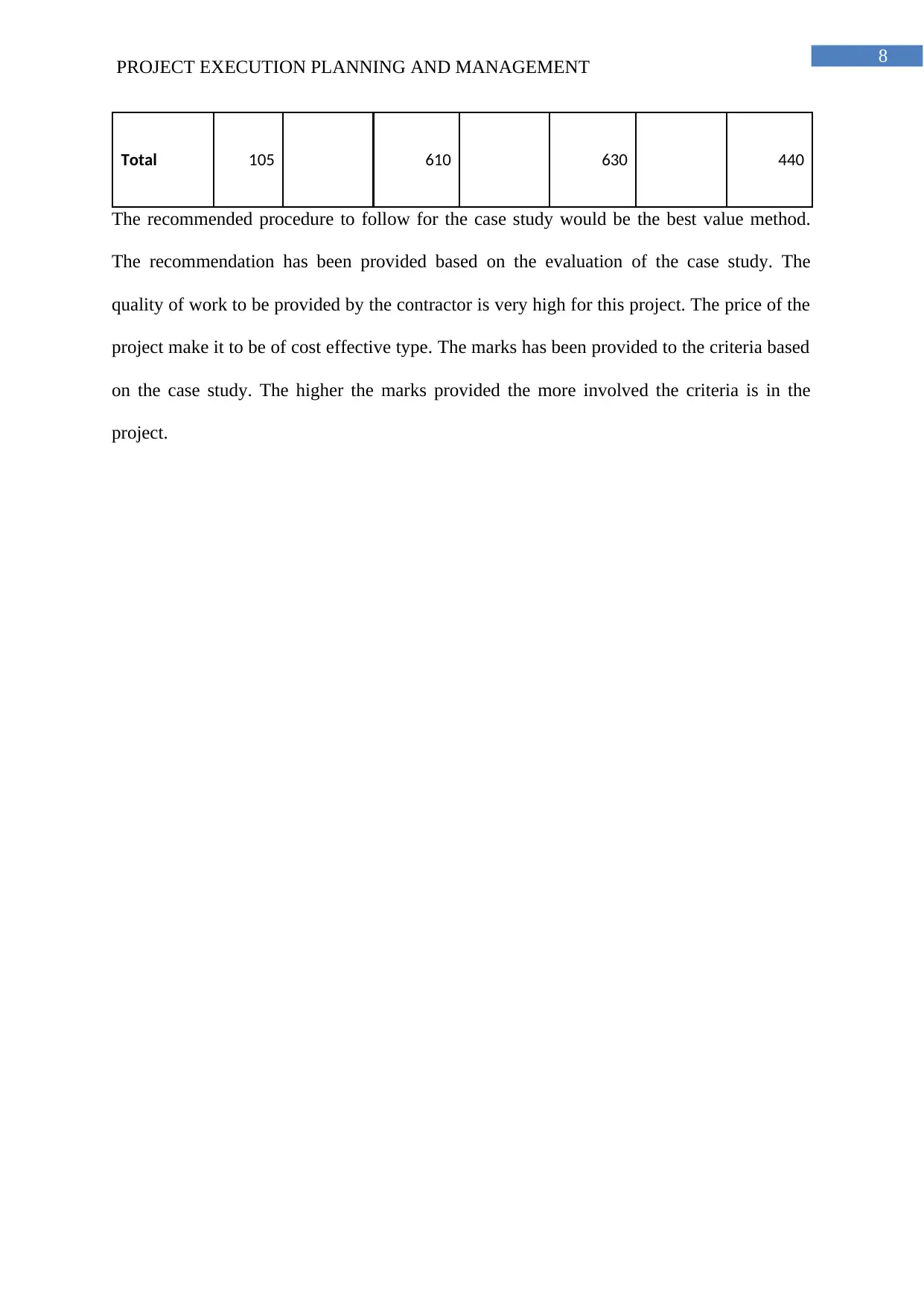
8
PROJECT EXECUTION PLANNING AND MANAGEMENT
Total 105 610 630 440
The recommended procedure to follow for the case study would be the best value method.
The recommendation has been provided based on the evaluation of the case study. The
quality of work to be provided by the contractor is very high for this project. The price of the
project make it to be of cost effective type. The marks has been provided to the criteria based
on the case study. The higher the marks provided the more involved the criteria is in the
project.
PROJECT EXECUTION PLANNING AND MANAGEMENT
Total 105 610 630 440
The recommended procedure to follow for the case study would be the best value method.
The recommendation has been provided based on the evaluation of the case study. The
quality of work to be provided by the contractor is very high for this project. The price of the
project make it to be of cost effective type. The marks has been provided to the criteria based
on the case study. The higher the marks provided the more involved the criteria is in the
project.
⊘ This is a preview!⊘
Do you want full access?
Subscribe today to unlock all pages.

Trusted by 1+ million students worldwide
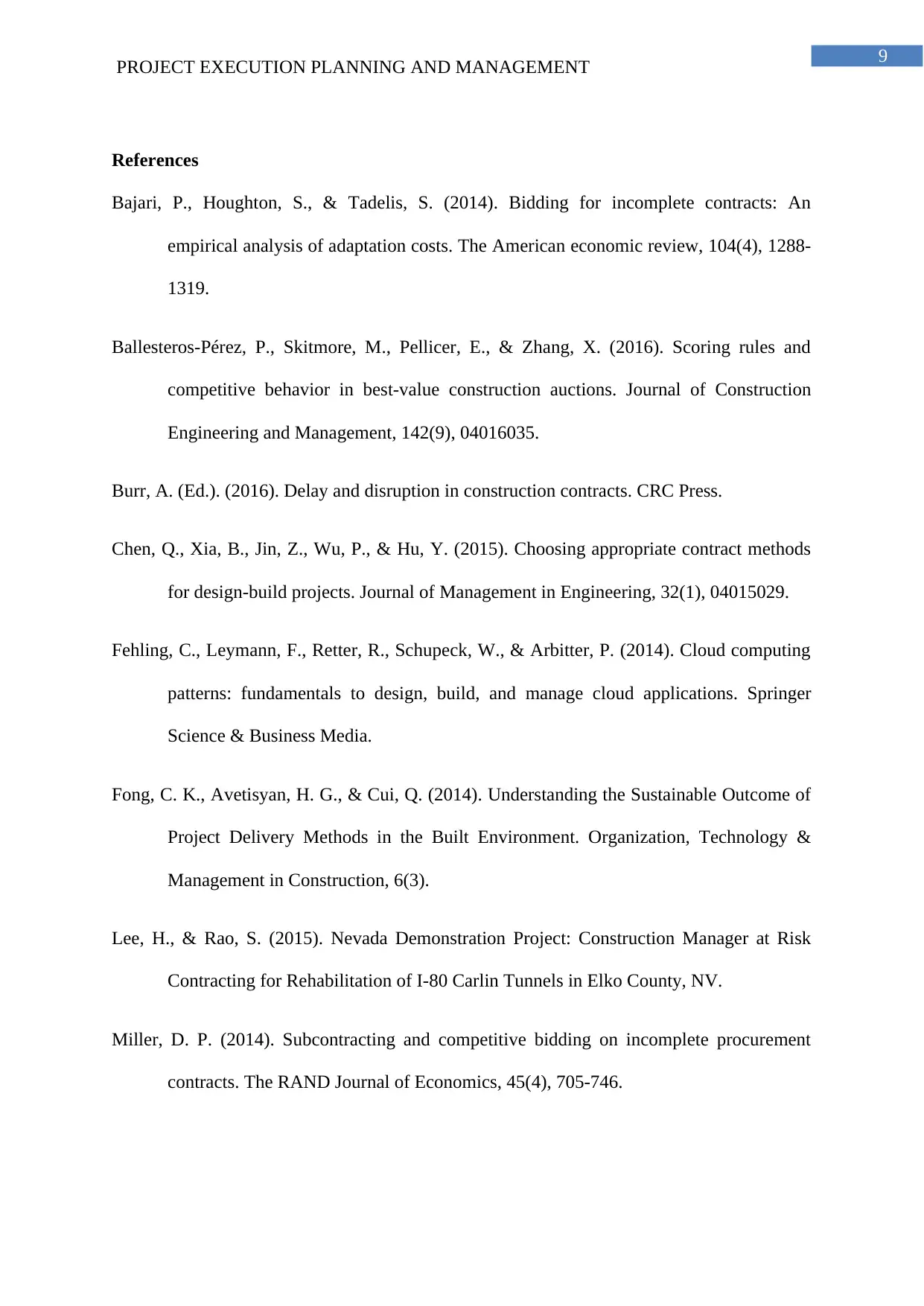
9
PROJECT EXECUTION PLANNING AND MANAGEMENT
References
Bajari, P., Houghton, S., & Tadelis, S. (2014). Bidding for incomplete contracts: An
empirical analysis of adaptation costs. The American economic review, 104(4), 1288-
1319.
Ballesteros-Pérez, P., Skitmore, M., Pellicer, E., & Zhang, X. (2016). Scoring rules and
competitive behavior in best-value construction auctions. Journal of Construction
Engineering and Management, 142(9), 04016035.
Burr, A. (Ed.). (2016). Delay and disruption in construction contracts. CRC Press.
Chen, Q., Xia, B., Jin, Z., Wu, P., & Hu, Y. (2015). Choosing appropriate contract methods
for design-build projects. Journal of Management in Engineering, 32(1), 04015029.
Fehling, C., Leymann, F., Retter, R., Schupeck, W., & Arbitter, P. (2014). Cloud computing
patterns: fundamentals to design, build, and manage cloud applications. Springer
Science & Business Media.
Fong, C. K., Avetisyan, H. G., & Cui, Q. (2014). Understanding the Sustainable Outcome of
Project Delivery Methods in the Built Environment. Organization, Technology &
Management in Construction, 6(3).
Lee, H., & Rao, S. (2015). Nevada Demonstration Project: Construction Manager at Risk
Contracting for Rehabilitation of I-80 Carlin Tunnels in Elko County, NV.
Miller, D. P. (2014). Subcontracting and competitive bidding on incomplete procurement
contracts. The RAND Journal of Economics, 45(4), 705-746.
PROJECT EXECUTION PLANNING AND MANAGEMENT
References
Bajari, P., Houghton, S., & Tadelis, S. (2014). Bidding for incomplete contracts: An
empirical analysis of adaptation costs. The American economic review, 104(4), 1288-
1319.
Ballesteros-Pérez, P., Skitmore, M., Pellicer, E., & Zhang, X. (2016). Scoring rules and
competitive behavior in best-value construction auctions. Journal of Construction
Engineering and Management, 142(9), 04016035.
Burr, A. (Ed.). (2016). Delay and disruption in construction contracts. CRC Press.
Chen, Q., Xia, B., Jin, Z., Wu, P., & Hu, Y. (2015). Choosing appropriate contract methods
for design-build projects. Journal of Management in Engineering, 32(1), 04015029.
Fehling, C., Leymann, F., Retter, R., Schupeck, W., & Arbitter, P. (2014). Cloud computing
patterns: fundamentals to design, build, and manage cloud applications. Springer
Science & Business Media.
Fong, C. K., Avetisyan, H. G., & Cui, Q. (2014). Understanding the Sustainable Outcome of
Project Delivery Methods in the Built Environment. Organization, Technology &
Management in Construction, 6(3).
Lee, H., & Rao, S. (2015). Nevada Demonstration Project: Construction Manager at Risk
Contracting for Rehabilitation of I-80 Carlin Tunnels in Elko County, NV.
Miller, D. P. (2014). Subcontracting and competitive bidding on incomplete procurement
contracts. The RAND Journal of Economics, 45(4), 705-746.
Paraphrase This Document
Need a fresh take? Get an instant paraphrase of this document with our AI Paraphraser
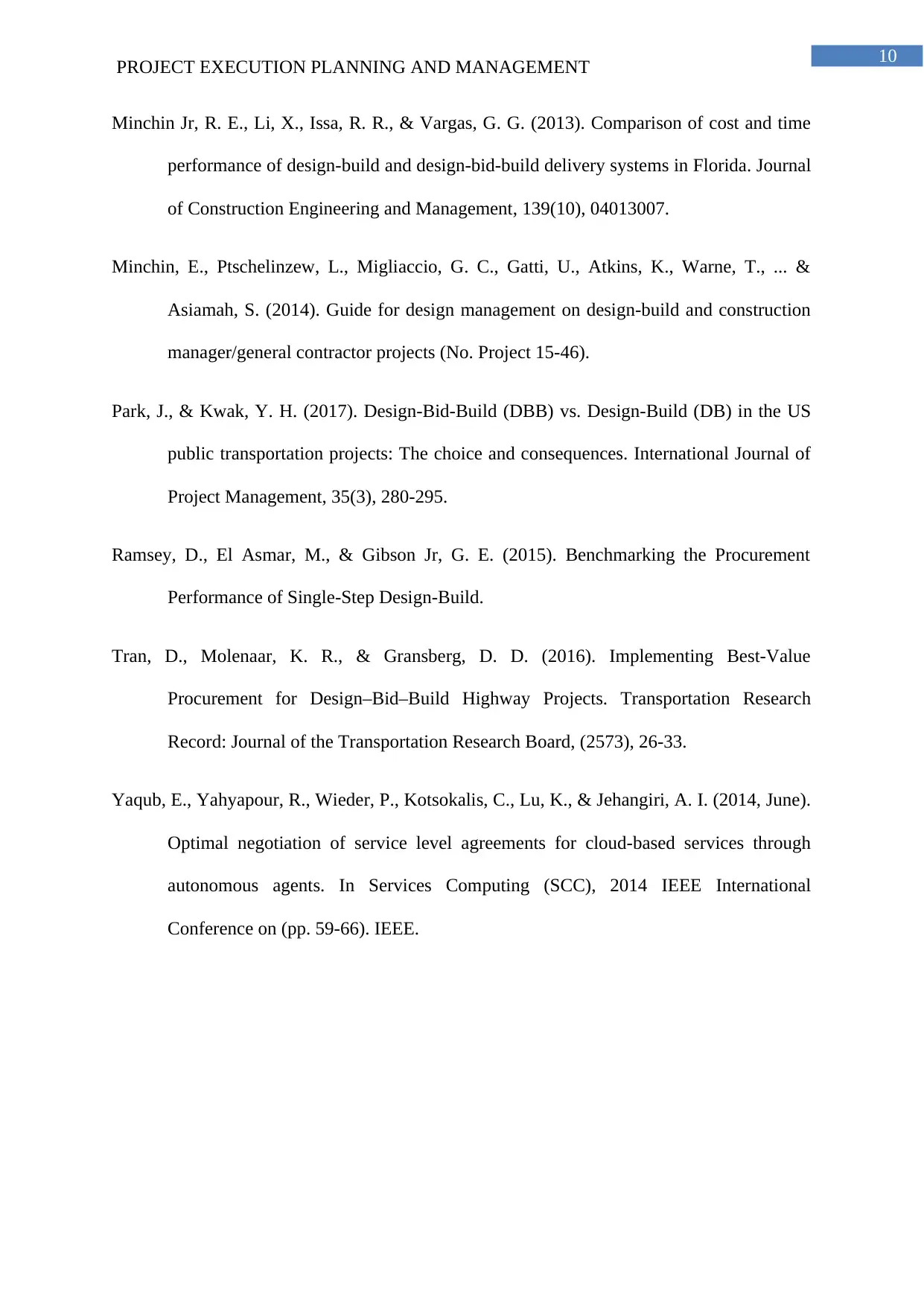
10
PROJECT EXECUTION PLANNING AND MANAGEMENT
Minchin Jr, R. E., Li, X., Issa, R. R., & Vargas, G. G. (2013). Comparison of cost and time
performance of design-build and design-bid-build delivery systems in Florida. Journal
of Construction Engineering and Management, 139(10), 04013007.
Minchin, E., Ptschelinzew, L., Migliaccio, G. C., Gatti, U., Atkins, K., Warne, T., ... &
Asiamah, S. (2014). Guide for design management on design-build and construction
manager/general contractor projects (No. Project 15-46).
Park, J., & Kwak, Y. H. (2017). Design-Bid-Build (DBB) vs. Design-Build (DB) in the US
public transportation projects: The choice and consequences. International Journal of
Project Management, 35(3), 280-295.
Ramsey, D., El Asmar, M., & Gibson Jr, G. E. (2015). Benchmarking the Procurement
Performance of Single-Step Design-Build.
Tran, D., Molenaar, K. R., & Gransberg, D. D. (2016). Implementing Best-Value
Procurement for Design–Bid–Build Highway Projects. Transportation Research
Record: Journal of the Transportation Research Board, (2573), 26-33.
Yaqub, E., Yahyapour, R., Wieder, P., Kotsokalis, C., Lu, K., & Jehangiri, A. I. (2014, June).
Optimal negotiation of service level agreements for cloud-based services through
autonomous agents. In Services Computing (SCC), 2014 IEEE International
Conference on (pp. 59-66). IEEE.
PROJECT EXECUTION PLANNING AND MANAGEMENT
Minchin Jr, R. E., Li, X., Issa, R. R., & Vargas, G. G. (2013). Comparison of cost and time
performance of design-build and design-bid-build delivery systems in Florida. Journal
of Construction Engineering and Management, 139(10), 04013007.
Minchin, E., Ptschelinzew, L., Migliaccio, G. C., Gatti, U., Atkins, K., Warne, T., ... &
Asiamah, S. (2014). Guide for design management on design-build and construction
manager/general contractor projects (No. Project 15-46).
Park, J., & Kwak, Y. H. (2017). Design-Bid-Build (DBB) vs. Design-Build (DB) in the US
public transportation projects: The choice and consequences. International Journal of
Project Management, 35(3), 280-295.
Ramsey, D., El Asmar, M., & Gibson Jr, G. E. (2015). Benchmarking the Procurement
Performance of Single-Step Design-Build.
Tran, D., Molenaar, K. R., & Gransberg, D. D. (2016). Implementing Best-Value
Procurement for Design–Bid–Build Highway Projects. Transportation Research
Record: Journal of the Transportation Research Board, (2573), 26-33.
Yaqub, E., Yahyapour, R., Wieder, P., Kotsokalis, C., Lu, K., & Jehangiri, A. I. (2014, June).
Optimal negotiation of service level agreements for cloud-based services through
autonomous agents. In Services Computing (SCC), 2014 IEEE International
Conference on (pp. 59-66). IEEE.
1 out of 11
Related Documents
Your All-in-One AI-Powered Toolkit for Academic Success.
+13062052269
info@desklib.com
Available 24*7 on WhatsApp / Email
![[object Object]](/_next/static/media/star-bottom.7253800d.svg)
Unlock your academic potential
Copyright © 2020–2025 A2Z Services. All Rights Reserved. Developed and managed by ZUCOL.



